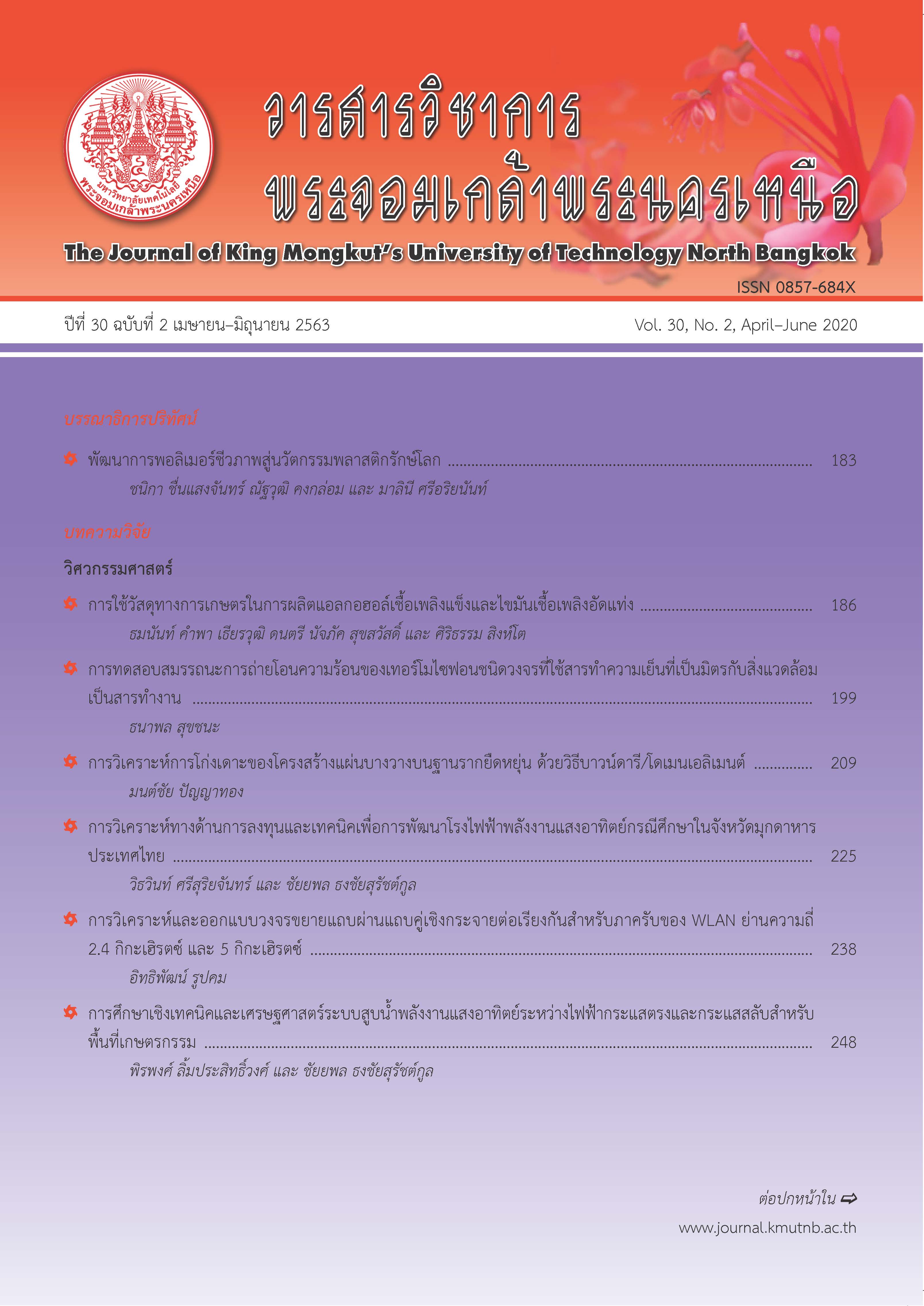การวิเคราะห์ทางด้านการลงทุนและเทคนิคเพื่อการพัฒนาโรงไฟฟ้าพลังงานแสงอาทิตย์กรณีศึกษาในจังหวัดมุกดาหาร ประเทศไทย
Main Article Content
บทคัดย่อ
งานวิจัยนี้นำเสนอการวิเคราะห์ทางด้านการลงทุนและเทคนิคในการพัฒนาโครงการโรงไฟฟ้าพลังงานแสงอาทิตย์ กรณีศึกษาดังกล่าวเป็นโรงไฟฟ้าพลังงานแสงอาทิตย์ขนาด 1 เมกะวัตต์ ตั้งอยู่ที่จังหวัดมุกดาหาร ประเทศไทย งานวิจัยนี้นำเสนอกระบวนการพัฒนาโครงการที่เหมาะสมโดยมีการพิจารณาทั้งทางด้านเศรษฐศาสตร์และทางด้านเทคนิค ปัจจัยที่ทำการศึกษาประกอบไปด้วย ต้นทุนการลงทุน ค่าพลังงานแสงอาทิตย์ ค่าพลังงานไฟฟ้าที่ผลิตได้ ชนิดแผงโซล่าเซลล์ ชนิดของอินเวอร์เตอร์ ผลกระทบจากสภาวะสิ่งแวดล้อมที่มีผลต่อประสิทธิภาพ ขนาดพื้นที่ติดตั้งและระบบโครงข่ายไฟฟ้าที่รองรับ โดยแผงโซล่าเซลล์ที่ใช้ได้ถูกจัดระดับโดยมีดัชนีชี้วัดในระดับ Tier 1 และมีการรับประกันผลิตภัณฑ์มากกว่า 10 ปี โดยมีประกันประสิทธิภาพการผลิตไฟฟ้าตลอดระยะเวลา 25 ปี ซึ่งการลดลงของพลังงานไฟฟ้าอันเนื่องมาจากการเสื่อมสภาพของแผงน้อยกว่า 0.8% ต่อปี หรือรวมกันแล้วไม่เกินกว่า 20% ประเภทอินเวอร์เตอร์ที่ใช้เป็นประเภทที่เชื่อมต่อกับระบบโครงข่ายไฟฟ้าได้ควรมีใบรับประกันเครื่องจากโรงงานการผลิต 5 ปีขึ้นไป และต้องได้รับการรับรองโดยมีดัชนีชี้วัดในระดับ Tier 1 ขนาดพื้นที่ในการติดตั้งโรงไฟฟ้าพลังงานแสงอาทิตย์ที่ได้นำเสนอนี้มีขนาด 7,000 ตารางเมตร ตำแหน่งการติดตั้งโรงไฟฟ้าพลังงานแสงอาทิตย์ต้องไม่ถูกบดบังจากต้นไม้ วัตถุ หรืออาคารจนทำให้เกิดเงาที่แผงโซลาเซลล์ โดยพื้นที่ต้องไม่อยู่ในบริเวณที่มีฝุ่นมากและไม่มีฝนตกชุกเกินไป พื้นที่ควรมีลักษณะราบเรียบและไม่เสี่ยงต่อการเกิดน้ำท่วม โรงไฟฟ้าพลังงานแสงอาทิตย์ต้องอยู่ใกล้ระบบโครงข่ายไฟฟ้าเพื่อง่ายต่อการเชื่อมต่อและยังช่วยลดต้นทุนในการเชื่อมต่อ ขณะเดียวกันต้องมั่นใจได้ว่าระบบโครงข่ายไฟฟ้าบริเวณนั้นมีความต้องการโหลดที่ตรงกับกำลังการผลิต จากผลการศึกษากรณีตัวอย่าง (โรงไฟฟ้าพลังงานแสงอาทิตย์มุกดาหาร) พบว่า พลังงานไฟฟ้าเฉลี่ยที่ผลิตได้คือ 1,506,000 กิโลวัตต์ชั่วโมงต่อปี มีอัตราผลตอบแทนภายใน (IRR) คือ 13.5% ค่าพลังงานแสงอาทิตย์บนพื้นผิวมากกว่า 4.1 กิโลวัตต์ชั่วโมงต่อตารางเมตรต่อวัน ประสิทธิภาพของโรงไฟฟ้าพลังงานแสงอาทิตย์ (Performance Ratio) มากกว่า 76.26%
Article Details
บทความที่ลงตีพิมพ์เป็นข้อคิดเห็นของผู้เขียนเท่านั้น
ผู้เขียนจะต้องเป็นผู้รับผิดชอบต่อผลทางกฎหมายใดๆ ที่อาจเกิดขึ้นจากบทความนั้น
เอกสารอ้างอิง
[2] World Energy Council. (2019, Jan.). World Energy Issues Monitor 2019. world energy council insights brief [Online]. Available: https://www.worldenergy.org/wp-content/uploads/2019/02/1.-World-Energy-Issues-Monitor-2019-Interactive-Full-Report.pdf
[3] C. Zou, Z. Qun, G. Zhang, and B. Xiong, “Energy revolution: From a fossil energy era to a new energy era,” Natural Gas Industry, vol. 3, no. 1, pp. 1–11, 2016.
[4] V. S. Ediger, “An integrated review and analysis of multi-energy transition from fossil fuels to renewables,” Energy Procedia, vol. 156, pp. 2–6, 2019.
[5] S. Glück, “Making energy cultures visible with situational analysis,” Energy Research & Social Science, vol. 45, p. 45, 2018.
[6] G. Q. Chen, X.D. Wu, J. Guo, J. Meng, and C. Li, “Global overview for energy use of the world economy: Household-consumption-based accounting based on the world input-output database (WIOD),” Energy Economics, vol. 81, no. c, pp. 835–847, 2019.
[7] Enerdata. (2019, Jan.). The global energy efficiency and demand database. [Online]. Available: https://www.enerdata.net
[8] International Energy Agency (IEA). (2018, Nov.). World Energy Outlook 2018. [Online].Available: https://www.ethz.ch/content/dam/ethz/speci alinterest/mavt/process- engineering/separationprocesses-laboratory-dam/documents/education/ccs%20notes/Wo rld%20Energy%20Outlook%202018.pdf
[9] International Energy Agency. (2018, Mar.). Global Energy and CO2 Status Report: The latest trends in energy and emissions in 2018. International Energy Agency [Online].Available: http://www.indiaenvironmentportal.org.in/file s/file/Global_Energy_and_CO2_Status_Report _2018.pdf
[10] World Energy Council. (2018, Jan.). World Energy Trilemma Index 2018. [Online]. Available: https://www.worldenergy.org/wp-content/uploads/2018/10/World-Energy-Trilemma-Index-2018.pdf
[11] Exxon Mobil Corporation (2017, Nov.). 2019 Energy & carbon summary. Exxon Mobil Corporation [Online]. Available: https://corporate.exxonmobil.com/-/media/Global/Files/energyand-carbon-summary/Energy-and-carbonsummary.pdf
[12] BP Statistical Review of World Energy BP p.l.c. (2019, Jan.). BP statistical review of world energy 2019: 68th edition. BP Statistical Review of World Energy. London, UK [Online]. Available: https://www.bp.com/content/dam/bp/business-sites/en/global/corporate/pdfs/energyeconomics/statistical-review/bp-stats-review-2019-full-report.pdf
[13] The Global CCS Institute. (2018 Jan.). Energy Demand in 2020. [Online]. Available: https://hub.globalccsinstitute.com/publications/ukrenewable-energy-strategy/energy-demand-2020
[14] U.S. Energy Information Administration. (2019 Jan.). Annual Energy Outlook 2019 with projections to 2050. International Energy Agency. Paris, France [Online]. Available: https://www.iea.org/weo2018
[15] S. Traivivatana, W. Wangjiraniran, S. Junlakarn, and N. Wansophark, “Thailand energy outlook for the Thailand integrated energy blueprint (TIEB),” Energy Procedia, vol. 138, pp. 399–404, 2017.
[16] International renewable Energy agency (2017, Apr.). Renewable Energy outlook Thailand 2017. Ministry of Energy. Bangkok, Thailand [Online]. Available: \https://www.irena.org/-/media/Files/IRENA/Agency/Publication/2017/Nov/IRENA_Outlook_Thailand_2017.pdf
[17] Ministry of Energy of Thailand. (2018, Apr.). Power Development Plan 2018. Ministry of Energy. Bangkok, Thailand [Online]. Available: http://www.eppo.go.th/images/Infro mation_service/public_relations/PDP2018/PD P2018.pdf
[18] Solar Magazine. (2019, Mar.). Thailand Solar Energy Profile. [Online]. Available: https://solarmagazine.com/solar-profiles/thailand/
[19] Energy Research Institute Chulalongkorn University. (2015, Dec.). Scaling Up Solar PV: A RoadMap for Thailand. Chulalongkorn University. Bangkok, Thailand [Online]. Available: http://www.dede.go.th/ewt_dl_link.php?nid=42059
[20] Asian Development Bank. (2015, Mar.) Handbook for Rooftop Solar Development in Aria. Asian Development Bank. Manila, Philippines [Online]. Available: https://www.adb.org/sites/default/files/public ation/153201/rooftopsolar-development-handbook.pdf
[21] The International Renewable Energy Agency (IRENA) (2012, Jun.). Renewable Energy Technologies: Cost Analysis Series. IRENA Secretariat. Abu Dhabi, United Arab Emirates [Online]. Available: https://www.solar-united.org/wp-content/uploads/2017/02/RE_Technologies_Cost_Analysis-SOLAR_PV.pdf
[22] Eclareon. (2014, Mar.). Pv rooftop development in Thailand analysis of regulations and challenges. Deutsche Gesellschaft für Internationale Zusammenarbeit (GIZ) GmbH. German [Online]. Available: http://www.thai-german-cooperation.info/download/20140408_pdp_th_report_pv_regulations.pdf
[23] S. Tongpong. (2017, Mar.). Solar Rooftop Power Generation Encouragement by Using Solar Hero Application. Provincial Electricity Authority (PEA). Bangkok, Thailand [Online]. Available: http://eit.or.th/paperseminar/National%20Engineering%202017.pdf
[24] Solar Power Europe. (2018, Mar.). Renewable Self-Consumption: Cheap and Clean Power at Your Doorstep. [Online]. Available: http://www.solarpowereurope.org/wp-content/uploads/2018/06/Self-consumption_final1507.pdf
[25] World weather online. (2018, February). Mukdahan Monthly Climate Averages. [Online]. Available: https://www.worldweatheronline.com/Mukdahan-weather-averages/Mukdahan/th.aspx
[26] M. Kaur and H. Singh, “A review comparison of silicon solar cells and thin film solar cells,” International Journal of Core Engineering & Management (IJCEM), vol. 3, no. 2, 2016.
[27] M. Imamzai, M. Aghaei, Y. Hanum Md Thayoob, and M. Forouzanfar, “A review on comparison between traditional silicon solar cells and thinfilm cdte solar cells” in Proceedings National Graduate Conference 2012 (NatGrad2012), University Tenaga National, Putrajaya Campus, 2012, pp. 1–5.
[28] C. Kalu, E. Isaac, and U. Mfonobong Anthony, “Comparative study of performance of three different photovoltaic technologies,” Mathematical and Software Engineering, vol. 2, no. 1, pp. 19–29, 2016.
[29] A. phowan and P. Sriphadungtham, “Performance analysis of polycrystalline silicon and thin film amorphous silicon solar cells,” presented at the 8th Electrical Engineering/Electronics, Computer, Telecommunications and Information Technology (ECTI), Khon Kaen, Thailand, May, 2011 (in Thai).
[30] F. Colville. (2019, Jan.). Top 10 solar module suppliers in 2018. PV-Tech & Solar Media Ltd., Solar Media. London, United Kingdom [Online]. Available: https://www.pv-tech.org/editorsblog/top-10- solar-module-suppliers-in-2018
[31] Global solar Atlas. (2019, Apr.). Map info Global Horizontal irradiation [Online]. Available: https://globalsolaratlas.info/?s=16.53833,104.715&m=sg:ghi&e=1
[32] C. Thongchaisuratkrul, “Studies and analysis the affecting factors for solar power,” In Research Report. Bangkok: King Mongkut’s University of Technology North Bangkok. 2016.
[33] W. Srisuriyajan and C. Thongchaisuratkrul, “The solar power plant prediction: A case study in Phitsanulok, Thailand,” The 2nd International Conference on Power and Energy Engineering (ICPEE 2018) Xiamen, China, Sept 3-5, 2018.
[34] W. Srisuriyajan and C. Thongchaisuratkrul, “The model of solar power plant efficiency improvement: A case study in Lampang, Thailand,” The International Conference on Advanced Mechanical and Electrical Engineering (AMEE 2018) Beijing, China, December 26–28, 2018.
[35] M.Z. Jacobson and V. Jadhav, “World estimates of PV optimal tilt angles and ratios of sunlight incident upon tilted and tracked PV panels relative to horizontal panels,” Solar Energy vol. 169, pp. 55–56, 2018.
[36] P. C. Acquah, “The Competency base training (CBT) concept of teaching and learning in the technical universities in GHANA: Challenges and the way forward,” Asia Pacific Journal of Contemporary Education and Technology, vol. 3, no. 2, pp. 172–182, 2017.
[37] W. Srisuriyajan and C. Thongchaisuratkrul, “The competency based training for aintenance technicians of solar power system focusing on solar modules,” in the 11th International conference on Technical Education, March 19–20, 2019.

